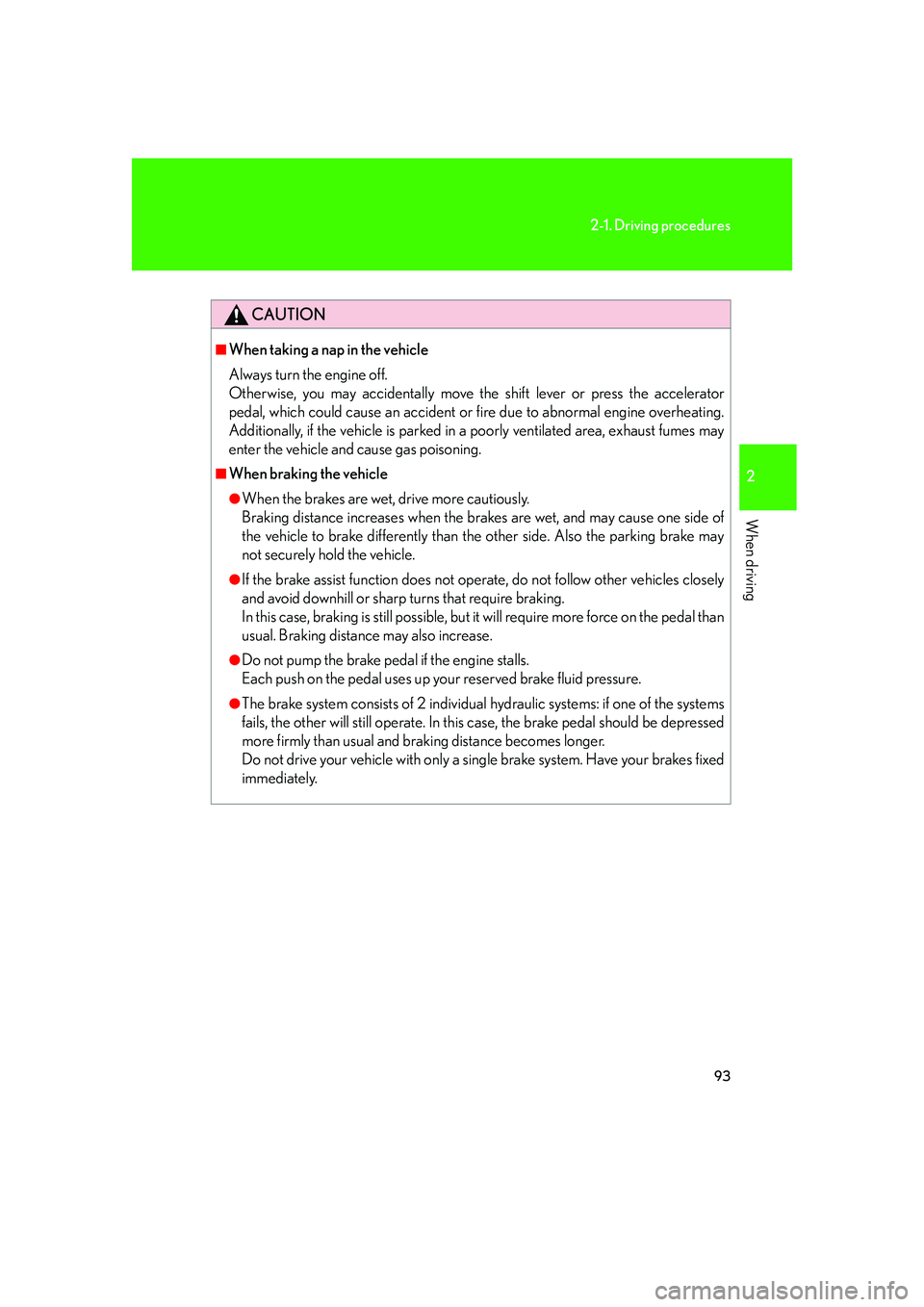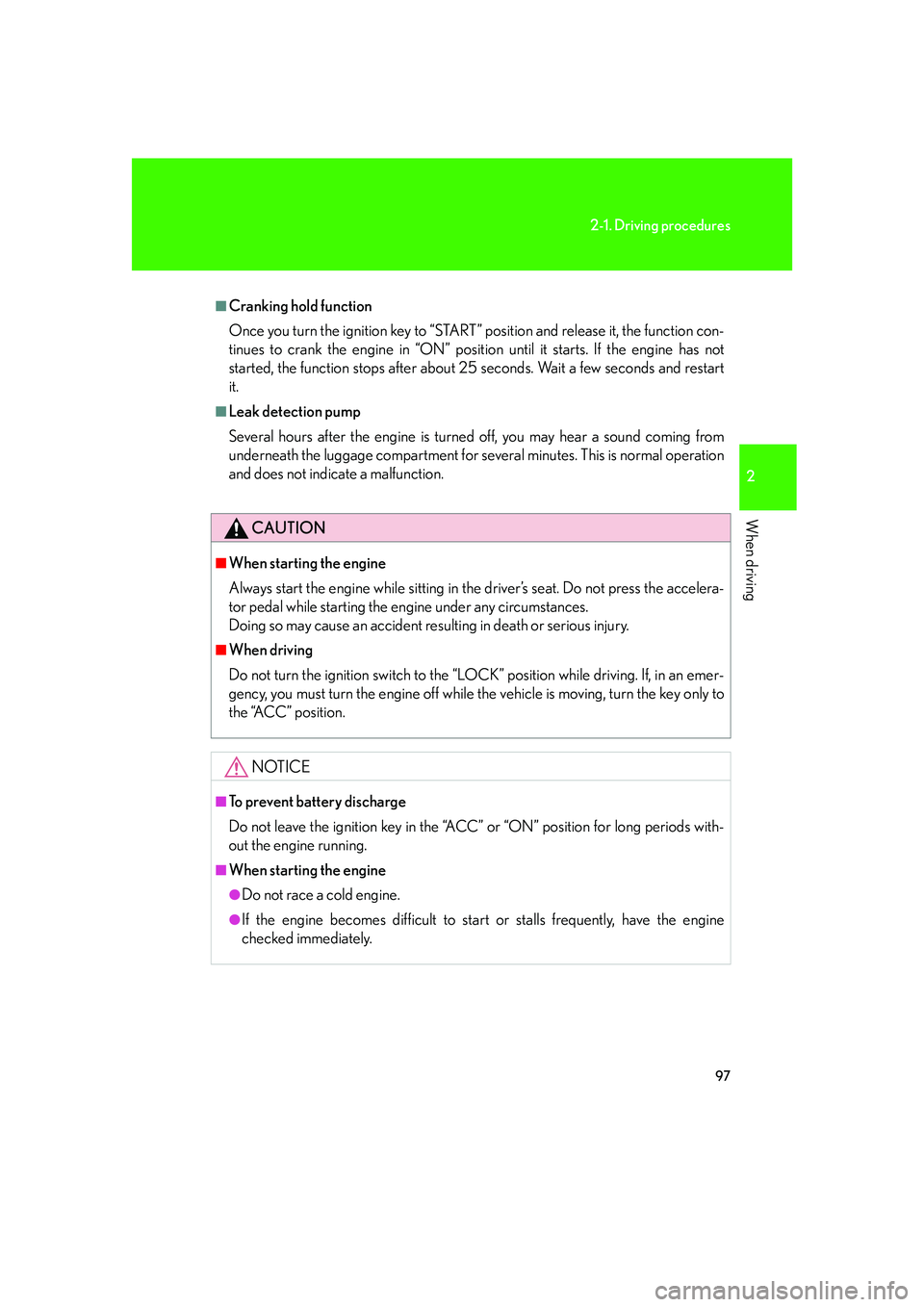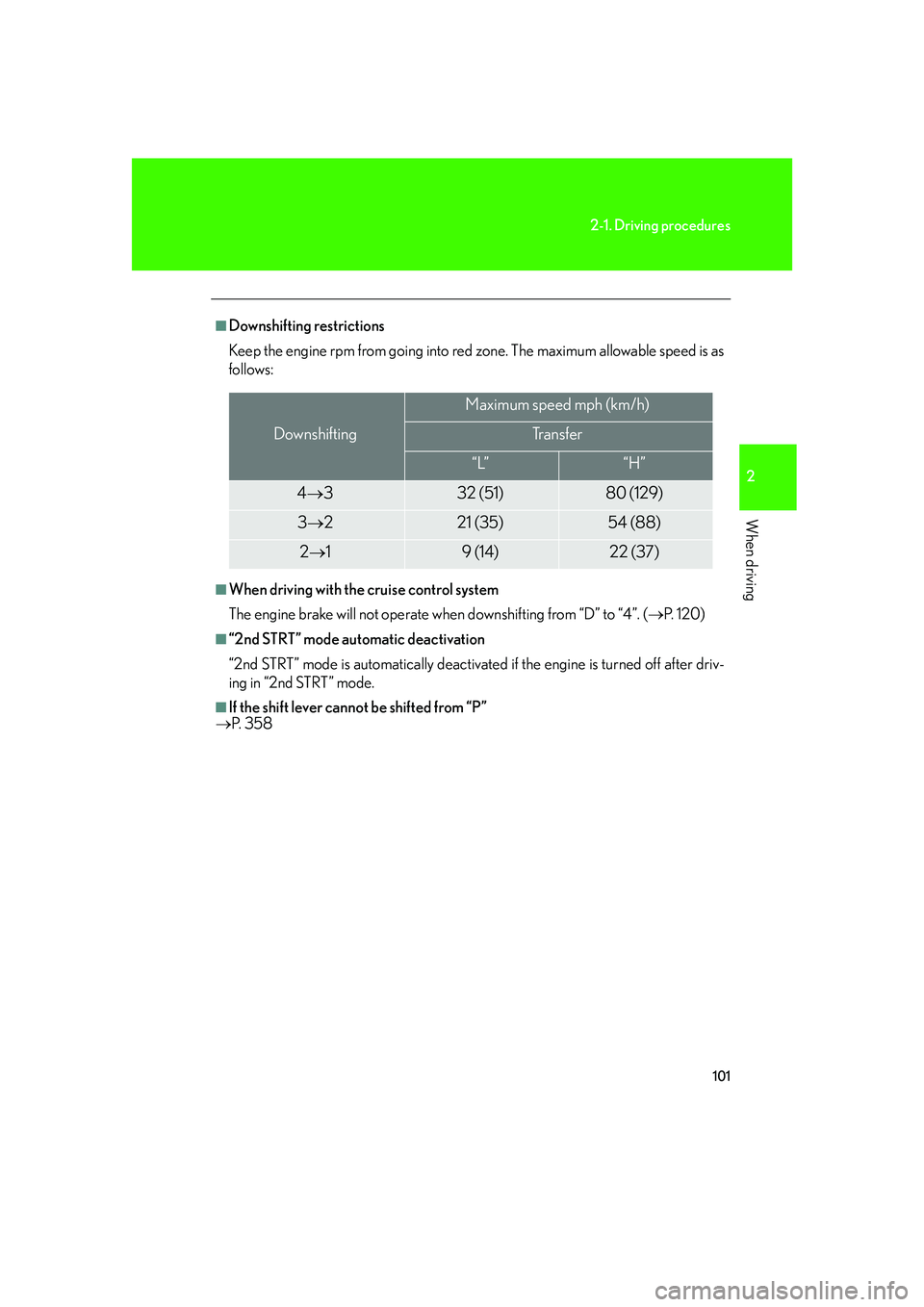LEXUS LX470 2007 Owners Manual
Manufacturer: LEXUS, Model Year: 2007, Model line: LX470, Model: LEXUS LX470 2007Pages: 426, PDF Size: 10.95 MB
Page 111 of 426

93
2-1. Driving procedures
2
When driving
CAUTION
■When taking a nap in the vehicle
Always turn the engine off.
Otherwise, you may accidentally move the shift lever or press the accelerator
pedal, which could cause an accident or fire due to abnormal engine overheating.
Additionally, if the vehicle is parked in a poorly ventilated area, exhaust fumes may
enter the vehicle and cause gas poisoning.
■When braking the vehicle
●When the brakes are wet, drive more cautiously.
Braking distance increases when the brakes are wet, and may cause one side of
the vehicle to brake differently than the other side. Also the parking brake may
not securely hold the vehicle.
●If the brake assist function does not operate, do not follow other vehicles closely
and avoid downhill or sharp turns that require braking.
In this case, braking is still possible, but it will require more force on the pedal than
usual. Braking distance may also increase.
●Do not pump the brake pedal if the engine stalls.
Each push on the pedal uses up your reserved brake fluid pressure.
●The brake system consists of 2 individual hydraulic systems: if one of the systems
fails, the other will still operate. In this case, the brake pedal should be depressed
more firmly than usual and braking distance becomes longer.
Do not drive your vehicle with only a single brake system. Have your brakes fixed
immediately.
Page 112 of 426

94
2-1. Driving procedures
NOTICE
■While driving the vehicle
Do not use the accelerator pedal or depress accelerator and brake pedals together
to hold the vehicle on a hill.
■When parking the vehicle
Always put the shift lever in “P”. Failure to do so may cause the vehicle to move or
the vehicle may accelerate suddenly if the accelerator pedal is accidentally
depressed.
■Avoiding damage to vehicle parts
●Do not turn the steering wheel fully in either direction and hold it there for a long
time.
Doing so may damage the power steering pump.
●When driving over bumps in the road, drive as slowly as possible to avoid damag-
ing the wheels, underside of the vehicle, etc.
■If you hear a squealing or scraping no ise (brake pad wear limit indicators)
Have your Lexus dealer check and replac e the brake pads as soon as possible.
The rotor damage can result if the pads are not replaced when needed.
It is dangerous to drive the vehicle when the wear limits of the brake pads and/or
that of the brake discs are exceeded.
■If you get a flat tire while driving
A flat or damaged tire may cause the following situations. Hold the steering wheel
firmly and gradually press the brak e pedal to slow down the vehicle.
●It may be difficult to control your vehicle.
●The vehicle will make abnormal sounds.
●The vehicle will behave abnormally.
Replace a flat tire with a new one. ( P. 3 4 6 )
Page 113 of 426
![LEXUS LX470 2007 Owners Manual 95
2-1. Driving procedures
2
When driving
Starting the engine
]
■Turning the key from “ACC” to “LOCK”
■Ignition switch
LOCK:
The steering wheel is locked
and the key can be removed.
ACC:
S LEXUS LX470 2007 Owners Manual 95
2-1. Driving procedures
2
When driving
Starting the engine
]
■Turning the key from “ACC” to “LOCK”
■Ignition switch
LOCK:
The steering wheel is locked
and the key can be removed.
ACC:
S](/img/36/58005/w960_58005-112.png)
95
2-1. Driving procedures
2
When driving
Starting the engine
]
■Turning the key from “ACC” to “LOCK”
■Ignition switch
LOCK:
The steering wheel is locked
and the key can be removed.
ACC:
Some electrical components
such as the audio system can be
used.
ON:
All electrical components can
be used.
START
■ Starting the engine
Check that the parking brake is set.
Check that the shift lever is set in “P”.
Sit in the driver’s seat and firmly depress the brake pedal.
Turn the ignition key to the “START” position and start the
engine.
STEP1
STEP2
STEP3
STEP4
Shift the shift lever to “P”.
Push in the key and turn to the
“LOCK” position.STEP1
STEP2
Page 114 of 426

96
2-1. Driving procedures
T■Steering lock release
■ If the engine does not start
The engine immobilizer system may not have been deactivated. (P. 4 7 )
■Starting the engine using the flat key
Put the key case away when the indicator light goes out. This means the
engine immobilizer system has turned off.
Start the engine within 60 seconds after the indicator light goes off.
When starting the engine, the ignition switch
may seem stuck in the “LOCK” position. To
free it, turn the ignition key while turning the
steering wheel sightly in either direction.
Remove the flat key from its case. Insert the
key into the ignition switch. STEP1
Bring the key case close to the ignition switch
within 10 seconds as indicated by an arrow. STEP2
STEP3
STEP4
Page 115 of 426

97
2-1. Driving procedures
2
When driving
■Cranking hold function
Once you turn the ignition key to “START” position and release it, the function con-
tinues to crank the engine in “ON” position until it starts. If the engine has not
started, the function stops after about 25 seconds. Wait a few seconds and restart
it.
■Leak detection pump
Several hours after the engine is turned off, you may hear a sound coming from
underneath the luggage compartment for several minutes. This is normal operation
and does not indicate a malfunction.
CAUTION
■When starting the engine
Always start the engine while sitting in the driver’s seat. Do not press the accelera-
tor pedal while starting the en gine under any circumstances.
Doing so may cause an accident resu lting in death or serious injury.
■When driving
Do not turn the ignition switch to the “LOCK” position while driving. If, in an emer-
gency, you must turn the engine off while the vehicle is moving, turn the key only to
the “ACC” position.
NOTICE
■To prevent battery discharge
Do not leave the ignition key in the “ACC” or “ON” position for long periods with-
out the engine running.
■When starting the engine
●Do not race a cold engine.
●If the engine becomes difficult to start or stalls frequently, have the engine
checked immediately.
Page 116 of 426

98
2-1. Driving procedures
Automatic transmission
Select a shift position appropriate for the driving conditions.
■Shifting the shift lever
While the ignition key is
in the “ON” position,
depress the brake pedal
and move the shift lever.
Page 117 of 426

99
2-1. Driving procedures
2
When driving
■Shift position uses
*: To improve fuel consumption and reduce noises, set the shift lever in the
“D” position for normal driving.
Shift positionFunction
PParking the vehicle or starting the engine
RReversing
NNeutral
DNormal driving*
4Position for engine braking
3,2Position for more powerful engine braking
LPosition for maximum engine braking
Page 118 of 426

100
2-1. Driving procedures
■Selecting a driving mode
The following patterns can be selec ted to suit current driving and
operating conditions.
Normal mode
Power mode
For powerful acceleration and
driving in mountainous regions.
“2nd STRT” (second start)
For starting on slippery road
surfaces, such as on snow.
Press “2nd” to return to normal
mode.
Page 119 of 426

101
2-1. Driving procedures
2
When driving
■Downshifting restrictions
Keep the engine rpm from going into red zone. The maximum allowable speed is as
follows:
■When driving with the cruise control system
The engine brake will not operate when downshifting from “D” to “4”. (P. 1 2 0 )
■“2nd STRT” mode automatic deactivation
“2nd STRT” mode is automatically deactivate d if the engine is turned off after driv-
ing in “2nd STRT” mode.
■If the shift lever cannot be shifted from “P”
P. 3 5 8
Downshifting
Maximum speed mph (km/h)
Tr a n s f e r
“L”“H”
4 332 (51)80 (129)
3 221 (35)54 (88)
2 19 (14)22 (37)
Page 120 of 426

102
2-1. Driving procedures
Turn signal lever
■Turn signals can be operated when
The ignition key is in the “ON” position.
■If the indicators flash faster than usual
Check that a light bulb in the front or rear turn signal lights has not burned out.
Left turn
Right turn
Move and hold the lever part-
way to signal a lane change
The left hand signal will flash
until you release the lever.
Move and hold the lever part-
way to signal a lane change
The right hand signal will flash
until you release the lever.